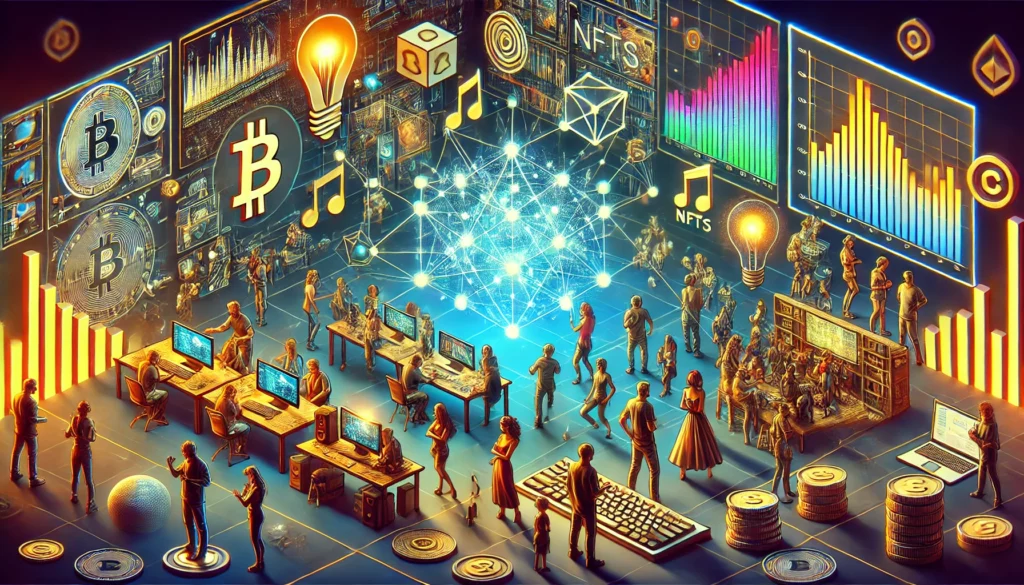The emergence of Web3 technologies is fundamentally transforming e-commerce by introducing decentralized marketplaces that prioritize user ownership, transparency, and efficiency. These marketplaces leverage blockchain technology to eliminate intermediaries, empowering creators and buyers to interact directly. In contrast to traditional Web2 platforms that often centralize control and impose high fees, Web3 marketplaces are decentralizing commerce, particularly in the realm of digital goods like art, music, and virtual assets. This shift is redefining how value is exchanged in the digital economy.
What Are Web3 Marketplaces?
Web3 marketplaces operate on decentralized networks powered by blockchain technology. At their core, these platforms facilitate peer-to-peer transactions, where smart contracts—self-executing agreements stored on the blockchain—automate processes such as payments, ownership transfers, and fulfillment. By removing the need for intermediaries, Web3 marketplaces provide a transparent, secure, and equitable environment for commerce.
Key features of Web3 marketplaces include:
- Decentralization: Transactions occur directly between users, without the need for a central authority.
- Transparency: Every transaction is recorded on a public blockchain, ensuring traceability and trust.
- User Ownership: Participants have control over their data, assets, and identities.
How Web3 Marketplaces Differ from Web2 Platforms
Traditional e-commerce platforms like Amazon and eBay rely on centralized systems where the platform operator controls everything, from data storage to transaction processing. While these platforms have revolutionized online shopping, they come with significant drawbacks:
- High Fees: Sellers are often charged substantial fees for listing products or completing sales.
- Limited Control: Creators and sellers rely on the platform’s policies, which can change without notice.
- Privacy Concerns: User data is typically owned and monetized by the platform, not the users.
Web3 marketplaces address these challenges:
- Lower Costs: By eliminating intermediaries, transaction fees are significantly reduced.
- Decentralized Ownership: Creators retain full control over their digital assets, including the ability to set terms for their use or sale.
- Enhanced Privacy: Blockchain-based marketplaces allow users to control and monetize their data without intermediaries.
Applications in Digital Goods
One of the most transformative aspects of Web3 marketplaces is their application to digital goods, such as art, music, and virtual real estate.
Non-Fungible Tokens (NFTs)
NFTs are the cornerstone of Web3 marketplaces, enabling the tokenization of digital assets. Artists, musicians, and creators can mint NFTs representing their work, which are then bought and sold on platforms like OpenSea, Rarible, and Foundation.
Benefits of NFTs in Web3 marketplaces:
- Ownership: Buyers gain verifiable ownership of digital assets, secured by the blockchain.
- Royalties: Smart contracts can ensure creators receive royalties from secondary sales.
- Global Reach: NFTs allow creators to connect with audiences and collectors worldwide.
Gaming and Virtual Assets
Web3 marketplaces are reshaping the gaming industry by enabling players to buy, sell, and trade in-game assets as NFTs. For example, in games like Axie Infinity and The Sandbox, players own characters, land, and items that can be monetized outside the game.
Advantages of Web3 Marketplaces
- Empowering Creators
- Web3 marketplaces enable creators to bypass traditional gatekeepers, such as record labels or art galleries, and sell their work directly to consumers.
- Lower Transaction Costs
- Reduced reliance on intermediaries leads to lower fees, allowing sellers to retain more of their earnings.
- Trust and Transparency
- Blockchain’s immutable ledger ensures that transactions are secure and traceable, reducing the risk of fraud.
- Interoperability
- Digital assets can often be used across multiple platforms and ecosystems, increasing their utility and value.
Challenges Facing Web3 Marketplaces
Despite their promise, Web3 marketplaces face several hurdles:
1. Scalability
Blockchain networks must handle large transaction volumes efficiently. Current limitations can lead to high fees and slow processing times, particularly on popular networks like Ethereum.
2. Complexity
For non-technical users, navigating blockchain wallets, gas fees, and smart contracts can be intimidating, creating barriers to adoption.
3. Regulatory Uncertainty
Governments are still grappling with how to regulate blockchain-based marketplaces, especially those involving NFTs and cryptocurrencies.
4. Environmental Concerns
The energy-intensive nature of some blockchain networks raises sustainability questions. However, eco-friendly blockchains like Solana and Ethereum’s transition to Proof of Stake are mitigating these issues.
The Future of Web3 Marketplaces
As Web3 technologies evolve, their potential to disrupt traditional e-commerce and digital economies will only grow. Key trends shaping the future include:
1. Mainstream Adoption
More user-friendly platforms and tools will make Web3 marketplaces accessible to broader audiences, driving adoption among creators and consumers alike.
2. Enhanced Interoperability
Blockchain advancements will enable seamless interaction between different networks, allowing users to move assets freely across platforms.
3. Integration with the Metaverse
Web3 marketplaces will play a central role in the development of the metaverse, facilitating the exchange of virtual goods, real estate, and experiences.
4. Greater Sustainability
The adoption of energy-efficient blockchains and sustainable practices will address environmental concerns, making Web3 marketplaces more viable in the long term.
Conclusion
Web3 marketplaces are redefining e-commerce by decentralizing transactions, empowering creators, and fostering transparency. By leveraging blockchain technology and NFTs, these platforms are creating a fairer, more inclusive digital economy where users have greater control over their assets and data.
While challenges like scalability, complexity, and regulation remain, the rapid pace of innovation suggests that Web3 marketplaces will continue to grow and reshape the way we buy, sell, and interact with digital goods. For creators, consumers, and businesses, the rise of Web3 represents a new era of opportunity in the digital age.


